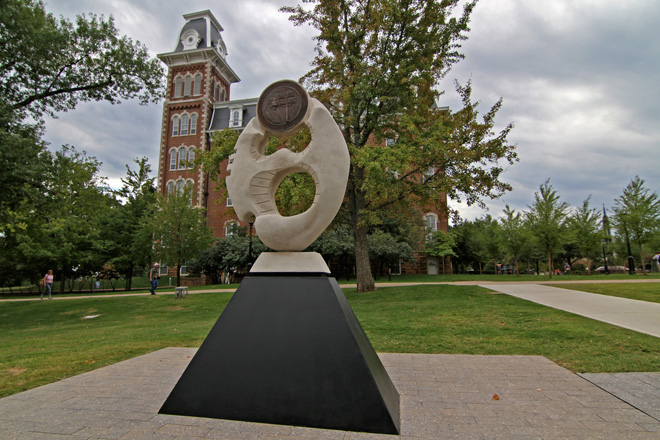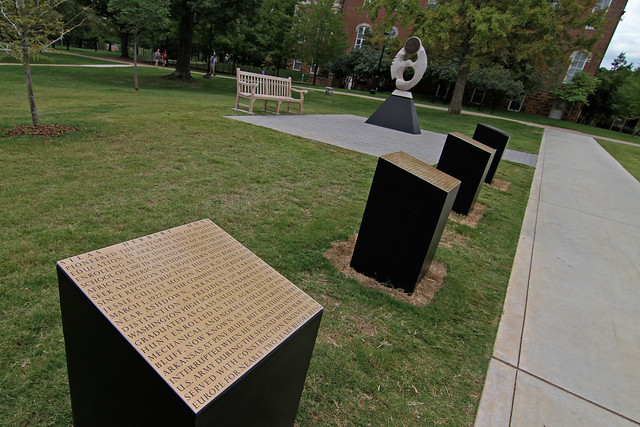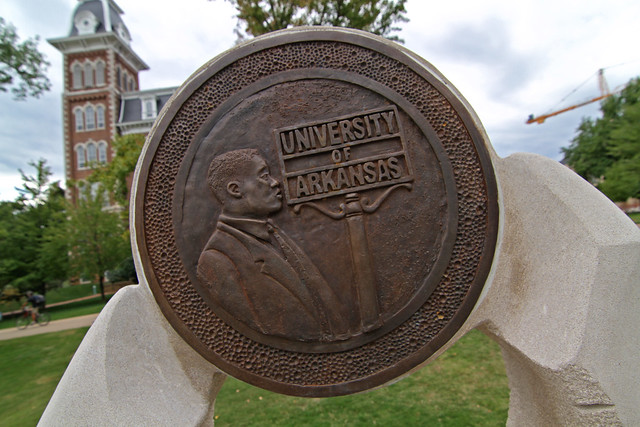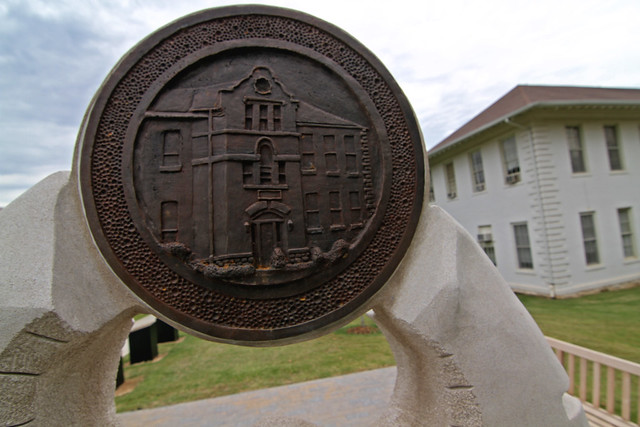
The Silas Hunt Memorial Sculpture stands near Old Main Wednesday morning on the University of Arkansas campus in Fayetteville.
Photo: Todd Gill
A sculpture honoring Silas Hunt, the first African-American law student at the University of Arkansas, was dedicated on the UA campus last week.
The Silas Hunt Memorial Sculpture, located between Old Main and the Academic Support Building, was created by University of Central Arkansas professor of art Bryan Massey Sr.
The sculpture is the first work of art commissioned by the university’s Public Art Oversight Committee, a group formed in 2009 as part of a major drive to increase the amount of art on display in outdoor areas throughout campus.
“We have a responsibility as the state’s flagship university to create a cultural experience for students, alumni and visitors,” said UA Chancellor G. David Gearhart. “The Northwest Arkansas region has become an international art destination, and the university should be a part of the pilgrimage.”
The nine-foot-tall sculpture is made of limestone and steel, and includes two bronze medallions – one that shows Hunt next to a sign that reads, “The University of Arkansas,” and another that depicts the university’s Academic Support Building where the law school was located when Hunt attended in 1948. Four black metal markers stand near the monument, three topped with gold plaques that tell the story of Hunt’s brief enrollment at the university.
Silas Herbert Hunt
Hunt, a decorated World War II veteran from Texarkana, enrolled in the University of Arkansas School of Law in February 1948. He completed one semester of classes before becoming ill and withdrawing from school. He died the next year from tuberculosis, aggravated by injuries he received during the war. Hunt’s admission to the university began the process of integration at the University of Arkansas and in colleges and universities across the southern United States.
Silas Hunt’s legacy can be found around campus in many ways. In 1993, Silas Hunt Hall was named. This building, located on Maple Street, is home to the university’s office of admissions, the Registrar’s office, the student accounts office and the office of financial aid. The Silas Hunt Scholarship Program, started in the fall of 2004, is a four-year academic scholarship that includes a comprehensive academic support program involving monthly meetings, peer mentoring and social resources for the scholarship recipients.The university’s Silas Hunt Legacy Award, introduced in April 2006, recognizes individuals for their significant achievements or contributions to the community, the state and the nation. Also in 2006, Silas Hunt: A Documentary premiered, a biographical film commissioned by Donnie Dutton, the former dean of what is now the Global Campus. In March 2011, the university dedicated the Silas Hunt Memorial Room in the Arkansas Union. This was the realization of a plan to promote diversity within the building.
Bryan Massey Sr.
Massey is primarily a stone carver who works with a variety of stone including alabaster, soapstone, limestone, marble and granite. He also casts iron, bronze and aluminum as well as working in the fabrication of steel sculptures.
He was recently selected as one of 84 artists nationally for inclusion in a new book called “Studios and Work Spaces of Black American Artists.” His most recent work, The Jazz Player, was selected and presented to former President Bill Clinton for the celebration and commemoration of the fifth-year anniversary of the Clinton Library in Little Rock in November 2009. It is now located in the Little Rock Sculpture Garden. A native North Carolinian, Massey has in Arkansas since 1988 with his wife of 26 years, Delphine. They have two daughters and one son. His work is exhibited internationally, nationally and regionally.
Text from the plaques near the sculpture
Silas Herbert Hunt pioneered the integration of higher education in Arkansas and the South, enrolling at the University of Arkansas School of Law in 1948 and becoming the first African-American student to successfully seek admission to a southern university since reconstruction. Hunt was born to Jessie Gulley Moton and R.D. Hunt on March 1, 1922, in the community of Red Bluff near Ashdown, Arkansas. He earned distinction as president of Booker T. Washington High School in Texarkana and graduated as Class Salutatorian in 1941. Hunt enrolled in the Agricultural, Mechanical, and Normal College at Pine Bluff, now known as the University of Arkansas at Pine Bluff, but his studies were interrupted when he was drafted into the U.S. Army during the second world war. He served with construction engineers in Europe for nearly two years before being wounded at the Battle of the Bulge. Returning to the United States, he finished his bachelor of arts in English in 1947. Although Hunt had been accepted for admission at the University of Indiana, he was inspired to change course by a classmate, Ada Lois Sipuel, who was then pursuing legal action to overturn the University of Oklahoma’s policy against admission of black students. Hunt decided to seek admission to the University of Arkansas. On February 22, 1948, Hunt – accompanied by classmate Wiley Branton, attorney Harold Flowers, and photographer Geleve Grice – met with Robert Leflar, dean of the University of Arkansas School of Law, who reviewed Hunt’s academic record and admitted him into the law school. Hunt’s instruction was initially segregated from white students, although white students often sat in on his class. By mid-summer of that year Hunt had contracted tuberculosis, and he died nine months later on April 22, 1949, at the Veteran’s Hospital in Springfield, Missouri. He is buried at Stateline Cemetery in Texarkana. Campus officials described Hunt as a confident and intelligent student whose sensitive way of dealing with others dampened the embers of conflict before they gained flame. His pioneering achievement soon led to the admission of other African-American students at the University of Arkansas and set in motion the eventual racial integration of universities across the southern United States. In honor of his achievements, the University of Arkansas awarded Hunt a posthumous law degree in 2008 and created a legacy award to recognize the achievements of African-American alumni, faculty, and staff who have contributed significantly to the betterment of Arkansas and the nation.






